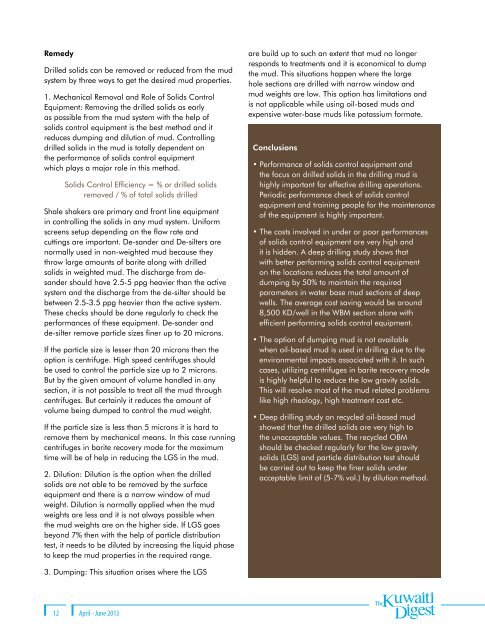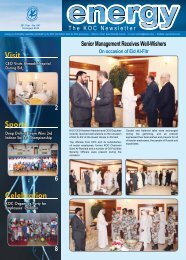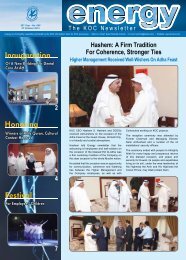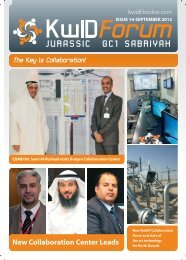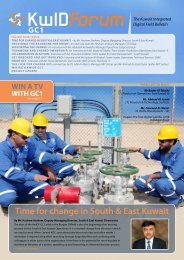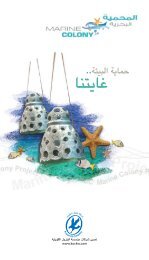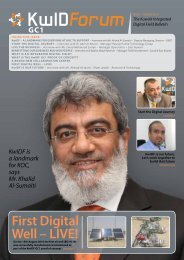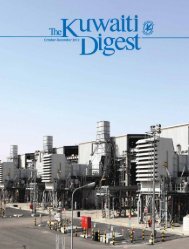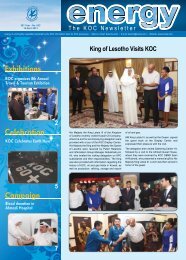6 - Kuwait Oil Company
6 - Kuwait Oil Company
6 - Kuwait Oil Company
Create successful ePaper yourself
Turn your PDF publications into a flip-book with our unique Google optimized e-Paper software.
Remedy<br />
Drilled solids can be removed or reduced from the mud<br />
system by three ways to get the desired mud properties.<br />
1. Mechanical Removal and Role of Solids Control<br />
Equipment: Removing the drilled solids as early<br />
as possible from the mud system with the help of<br />
solids control equipment is the best method and it<br />
reduces dumping and dilution of mud. Controlling<br />
drilled solids in the mud is totally dependent on<br />
the performance of solids control equipment<br />
which plays a major role in this method.<br />
Solids Control Efficiency = % or drilled solids<br />
removed / % of total solids drilled<br />
Shale shakers are primary and front line equipment<br />
in controlling the solids in any mud system. Uniform<br />
screens setup depending on the flow rate and<br />
cuttings are important. De-sander and De-silters are<br />
normally used in non-weighted mud because they<br />
throw large amounts of barite along with drilled<br />
solids in weighted mud. The discharge from desander<br />
should have 2.5-5 ppg heavier than the active<br />
system and the discharge from the de-silter should be<br />
between 2.5-3.5 ppg heavier than the active system.<br />
These checks should be done regularly to check the<br />
performances of these equipment. De-sander and<br />
de-silter remove particle sizes finer up to 20 microns.<br />
If the particle size is lesser than 20 microns then the<br />
option is centrifuge. High speed centrifuges should<br />
be used to control the particle size up to 2 microns.<br />
But by the given amount of volume handled in any<br />
section, it is not possible to treat all the mud through<br />
centrifuges. But certainly it reduces the amount of<br />
volume being dumped to control the mud weight.<br />
If the particle size is less than 5 microns it is hard to<br />
remove them by mechanical means. In this case running<br />
centrifuges in barite recovery mode for the maximum<br />
time will be of help in reducing the LGS in the mud.<br />
2. Dilution: Dilution is the option when the drilled<br />
solids are not able to be removed by the surface<br />
equipment and there is a narrow window of mud<br />
weight. Dilution is normally applied when the mud<br />
weights are less and it is not always possible when<br />
the mud weights are on the higher side. If LGS goes<br />
beyond 7% then with the help of particle distribution<br />
test, it needs to be diluted by increasing the liquid phase<br />
to keep the mud properties in the required range.<br />
are build up to such an extent that mud no longer<br />
responds to treatments and it is economical to dump<br />
the mud. This situations happen where the large<br />
hole sections are drilled with narrow window and<br />
mud weights are low. This option has limitations and<br />
is not applicable while using oil-based muds and<br />
expensive water-base muds like potassium formate.<br />
Conclusions<br />
• Performance of solids control equipment and<br />
the focus on drilled solids in the drilling mud is<br />
highly important for effective drilling operations.<br />
Periodic performance check of solids control<br />
equipment and training people for the maintenance<br />
of the equipment is highly important.<br />
• The costs involved in under or poor performances<br />
of solids control equipment are very high and<br />
it is hidden. A deep drilling study shows that<br />
with better performing solids control equipment<br />
on the locations reduces the total amount of<br />
dumping by 50% to maintain the required<br />
parameters in water base mud sections of deep<br />
wells. The average cost saving would be around<br />
8,500 KD/well in the WBM section alone with<br />
efficient performing solids control equipment.<br />
• The option of dumping mud is not available<br />
when oil-based mud is used in drilling due to the<br />
environmental impacts associated with it. In such<br />
cases, utilizing centrifuges in barite recovery mode<br />
is highly helpful to reduce the low gravity solids.<br />
This will resolve most of the mud related problems<br />
like high rheology, high treatment cost etc.<br />
• Deep drilling study on recycled oil-based mud<br />
showed that the drilled solids are very high to<br />
the unacceptable values. The recycled OBM<br />
should be checked regularly for the low gravity<br />
solids (LGS) and particle distribution test should<br />
be carried out to keep the finer solids under<br />
acceptable limit of (5-7% vol.) by dilution method.<br />
3. Dumping: This situation arises where the LGS<br />
12<br />
April - June 2013


